Plumbing and HVAC contractors are invited to register for CONNECT 2025, taking place from October 27-30, 2025. Plumbing-Heating-Cooling Contractors–National Association (PHCC), encourages plumbing and HVAC contractors to make plans now to be part of PHCC CONNECT 2025. Industry professionals are invited to join for three days packed with valuable education and networking opportunities. PHCC Read more
Plumbing-Heating-Cooling Contractors
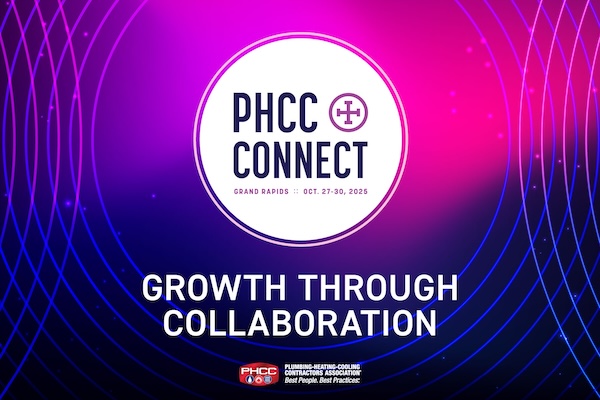
Falls Church, Va. — Plumbing-heating-cooling contractors are feeling cautiously optimistic, according to a new report from the Plumbing-Heating-Cooling Contractors — National Association. The PHCC Business Intelligence Department just released its newly developed Contractor Confidence Index (CCI). Sponsored by PHCC Strategic Partner Bradford White, the PHCC CCI is based on a quarterly survey of PHCC members designed to take Read more
Falls Church, Va. — Plumbing-heating-cooling contractors are feeling cautiously optimistic, according to a new report from the Plumbing-Heating-Cooling Contractors — National Association. The PHCC Business Intelligence Department just released its newly developed Contractor Confidence Index (CCI). Sponsored by PHCC Strategic Partner Bradford White, the PHCC CCI is based on a quarterly survey of PHCC members designed to take the pulse of the plumbing, heating, and cooling market.
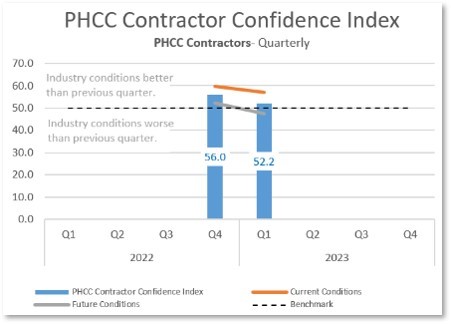 The PHCC First Quarter 2023 CCI summary report revealed a CCI of 52.2, meaning contractors believe industry conditions are better than the previous six months, but are trending lower because of ongoing challenges. The first quarter CCI dropped from 56.0 in the Fourth Quarter of 2022, with an increasing number of respondents citing economic uncertainty and fear of a coming recession.
The PHCC First Quarter 2023 CCI summary report revealed a CCI of 52.2, meaning contractors believe industry conditions are better than the previous six months, but are trending lower because of ongoing challenges. The first quarter CCI dropped from 56.0 in the Fourth Quarter of 2022, with an increasing number of respondents citing economic uncertainty and fear of a coming recession.
Any rating over 50 indicates a higher share of PHCC contractors reporting industry conditions are better than they were in the previous quarter, while any rating under 50 indicates a higher share of respondents reporting conditions are worse than they were in the previous quarter.
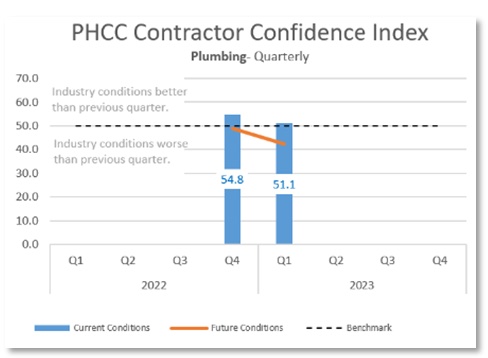 Plumbing contractors reported a lower future confidence index of 42.2 percent, versus 48.9 percent in the fourth quarter 2022, indicating that contractors who own plumbing businesses believe industry conditions were worse than the previous six months. HVAC contractors reported a higher future confidence index of 56 percent, versus 60.6 percent in the fourth quarter, suggesting industry conditions still feel better than the previous six months, though sentiment is trending lower.
Plumbing contractors reported a lower future confidence index of 42.2 percent, versus 48.9 percent in the fourth quarter 2022, indicating that contractors who own plumbing businesses believe industry conditions were worse than the previous six months. HVAC contractors reported a higher future confidence index of 56 percent, versus 60.6 percent in the fourth quarter, suggesting industry conditions still feel better than the previous six months, though sentiment is trending lower.
The top contractor challenges reported were:
- Operating short-staffed
- Customers holding off on projects
- Low call volumes
- Too much work
- New construction slowdown
While roughly 70 percent of PHCC Contractor respondents anticipated normal to better sales in the future, 30 percent of respondents are not operating with a full staff, employees, and technicians. Double the number of respondents reported that customers are holding off on projects and replacements due to economic concerns — a significant increase when compared to fourth quarter results. 72 percent cited rising costs, and half of the respondents noted delays in shipping materials. The results were flat at 25 percent for those who indicated concerns about lower construction starts when compared to the last quarter.
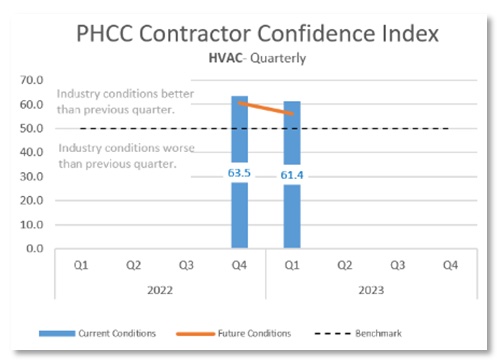 Looking ahead, 73 percent of PHCC respondents are anticipating increased cost of doing business (parts, materials, labor), and most of those respondents are worried about an impeding recession, as well as continued challenges finding qualified employees and technicians.
Looking ahead, 73 percent of PHCC respondents are anticipating increased cost of doing business (parts, materials, labor), and most of those respondents are worried about an impeding recession, as well as continued challenges finding qualified employees and technicians.
The top three concerns for contractors over the next six months include the cost of health insurance, fear of recession, and increased (additional) insurance costs. Additional concerns were increased regulations, decreased construction starts, and cash flow.
“We are very pleased to unveil this first quarter 2023 Contractor Confidence Index that will help us determine the current sentiment of PHCC members,” said PHCC—National Association President Dave Frame. “With access to this valuable information, our members will be able to track challenges and trends that affect their business, as well as maximize any business opportunities that are identified. And from an organization perspective, PHCC will be well-positioned to identify and develop programs and services that will meet our members’ needs.”
The PHCC Business Intelligence Department works to favorably position PHCC members and affiliates to achieve the highest level of market awareness, professionalism, leadership, and business profitability in the emerging and ever-changing built environment. Relevant resources are updated on a regular basis on the new PHCC Business Intelligence website: www.phccweb.org/business-intelligence.
Disclaimer: The PHCC Contractor Confidence Index (CCI) is based on a quarterly survey of PHCC members designed to take the pulse of the plumbing heating and cooling market. The survey asks respondents to rate market conditions for the present time and for the next six months. Survey results and the PHCC CCI were developed as a general sense of contractor sentiment and should not be used as a guaranteed indication of future performance of economic and industry performance. Many PHCC Contractors provide both plumbing and HVAC installation and service.
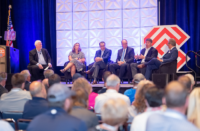
Monumental concerns in the industry—from supply chain issues and inflation concerns to electrification and decarbonization—challenge contractors and manufacturers alike to be ready to rise above the fray. On September 28, Hurricane Ian, a Category 4 storm, hit the Florida coast, leaving a trail of destruction, loss of life, and people without power, and a place Read more
Monumental concerns in the industry—from supply chain issues and inflation concerns to electrification and decarbonization—challenge contractors and manufacturers alike to be ready to rise above the fray.
On September 28, Hurricane Ian, a Category 4 storm, hit the Florida coast, leaving a trail of destruction, loss of life, and people without power, and a place to live. The following week, after the residual rains moved through the South Atlantic states, PHCC CONNECT attendees, exhibitors and staff were fortunate to convene in Charlotte, N.C. for the annual show.
One of the many bright spots during CONNECT was the annual Industry Perspective panel—back by popular demand—which featured some of the industry’s finest: Elisabeth Sutton, Director—Marketing, Professional Channel, Kitchen and Bath Americas, Kohler; Bruce Carnevale, President and CEO, Bradford White Corporation; Randy Roberts, Vice President of Sales and Marketing, Rheem; Scott Teson, Senior Vice President of Skilled Trades, Milwaukee Tool; Jeff Fetters, Chairman, Federated Insurance Companies.
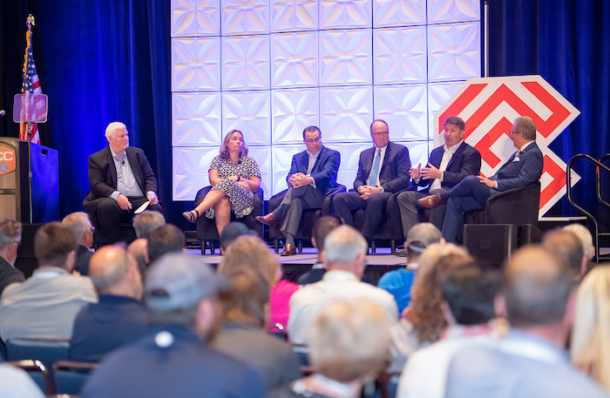
As I prepared for the panel, I would have been remiss if I didn’t mention those people still struggling in the Sunshine State. And the more I thought about what was happening in Florida, the more I could draw some symmetry of what has been plaguing our nation the past few years.
Things like supply chain. Are the right people getting what they need in Florida? Labor shortage. Do we have the manpower to provide assistance? Or, do we have the proper infrastructure in place? What about electrification? I mean, I had just seen a meme that said something like, “2.8 million people without power, time to fire up the Teslas.” Now that could be perceived as a bit naïve, but when you look at California, for instance—declaring no new gas cars sold in the state by 2035—concerns about adequate infrastructure are real.
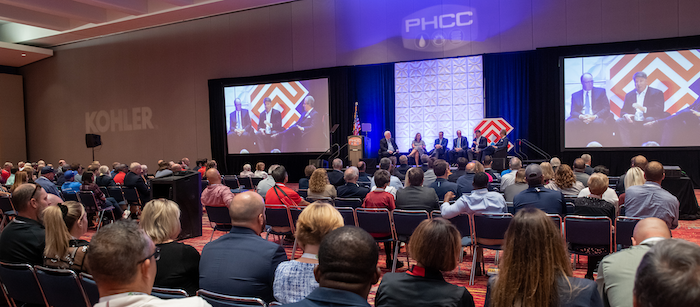
It’s a good thing we had the right people on the panel to address such concerns. I learned that Federated Insurance sent “catastrophic teams” to Florida to help. “We needed to have boots on the ground as quickly as we could,” said Fetters. “Businesses need to have high expectations for employees to remain safe. Disasters can strike at any time. A risk management culture has to perpetuate through every single employee,” said Fetters.
As a side note, how can contractors prepare for such an event? “Make sure you sit down with an agent to see what it would cost to replace your business, and any personal property in the event of any potential catastrophe,” said Fetters.
Supply Chain Woes
Nonetheless, supply chain issues dominate conversation almost daily among working contractors. “We are still challenged by supply chain issues, and it has forced us as a company to better manage our supply chain. We do things differently now,” said Carnevale.
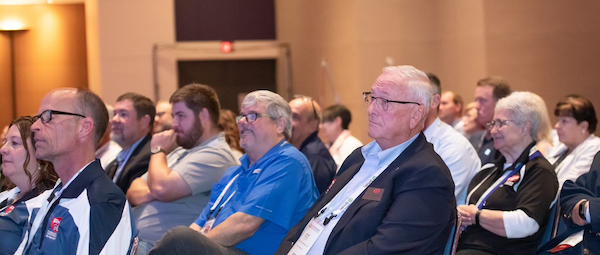
As a manufacturer, you’re never getting what you need from plastic resins overseas, nickel component slowing lines down to component issue challenges,” said Roberts. “This makes us be creative on managing supply chain.”
According to Sutton, “We see that luxury side of remodeling is still high. The thing impacting supply chain is that distributors are receiving more products, managing inventory for distributors.”
Investments in People/Training
Milwaukee Tool has made an $400 million investment in domestic manufacturing. “We want to control our own destiny,” said Teson. Yet, Teson pointed out that with more commercial construction projects on the books, how do we find the right people to support those jobs? “We need skilled tradesmen and women to support those efforts,” said Teson.
Sutton suggests that technology in products is a viable avenue to attract the younger generation. C’mon, who doesn’t like the way an impact driver or press tool feels in their hands?
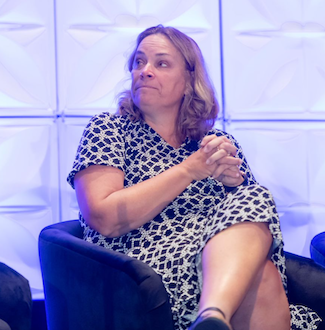
Elisabeth Sutton
“We also need to attract people to the industry to show them how wonderful it is, and that should not be specific to one type of person,” said Sutton. “We need more diversity, not just one profile,” continued Sutton.
“This is a fantastic industry, and once people are a part of it, they stay,” said Roberts.
Yet, once in the building, how do we get people to stay? Training. “It has always been a critical part of what we do. We have been very flexible with our training—we will take it to customers and also bring them into our facility,” said Carnevale.
How do employees continue to get better year after year? The panel agreed that it’s about establishing a culture of training in your office. This gives employers a competitive advantage in keeping people and attracting people because they will be seen as investing in them.
Electrification is the Buzzword
According to Carnevale, topics surrounding electrification loom large. For example, will the infrastructure be in place to support the new products? How will the infrastructure build out in a very short time? This puts the consumer in a bad position and puts our national security at risk—i.e., supply chain issues and the country’s fragile relationship with China.
“Electrification and decarbonization, whether we like it or not, we need to be prepared. We have the products available,” said Roberts.
Government Regulations
Carnevale noted that he receives email relating to a regulatory issue almost daily. “The DoE is extremely active, and there’s a requirement that is in the foundational law that once the DOE sets a new minimum efficiency standard, it cannot go backward.”
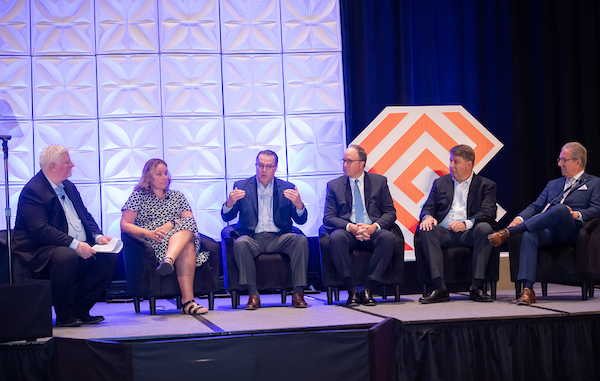
The panel consisted of (from l to r): John Mesenbrink, moderator; Elisabeth Sutton, Kohler; Bruce Carnevale, Bradford White; Randy Roberts, Rheem; Scott Teson, Milwaukee Tool; Jeff Fetters, Federated Insurance.
According to Rheem’s Roberts, there is an “Install Date Standard for Air Conditioning Systems” looming and, “Contractors will be breaking the law if they install an AC system not rated to the new standard come January, 1 2023.” Efficiency standards dictate that sell through of existing systems will be allowed in the northern states if the product was manufactured prior to January 1, 2023. This is not the case in the South and Southwest. AC systems must comply with the 2023 federal minimums to be installed after January 1, 2023. Current Heat Pump systems can continue to be installed in all regions as long as they were manufactured before January 1.
And who is enforcing this, you may ask? “Contractors and distributors will be self-policing installations to make sure they meet the new standard. In addition, manufacturers cannot ship products that don’t meet the new standards or allow them to be registered for warranties if installed after January 1. A standard based on install date will ultimately create inventory challenges for everyone in the industry,” said Roberts.
That Dreaded ‘R’ Word
There are whispers of the “R” word and I don’t think it means that “relief” is on the way anytime soon. From inflation to fuel prices, contractors have faced economic hardships that may continue to linger into 2023, and beyond. “We’ve been bearish on the economy longer than the financial press has been,” says Carnevale. “It is pretty clear that we are in a recession. There have been some positive signs, the fed is getting aggressive, and we will see significant drop in housing market.”
Carnevale continued that he is concerned about the macro economy, even though there are some good signs. “Labor shortages continue to be a vexing problem, and we need to focus on the labor participation rate compared to pre-pandemic, meaning there are a lot of people who are choosing not to work,” said Carnevale.
Teson said that interest rates are the real threat. “We’re watching it very closely and trying to make decisions that will make us come out stronger than our competitors.”
Carnevale added that there is a very distinct demand for discretionary vs. non-discretionary products. In the end, “As the demand starts to soften, we are subject to the laws of supply and demand. It is not going got back to where it is pre-pandemic, but will see some softening on pricing.”
Roberts says that overall, we should see a correction. “How do you position yourself to come out stronger than you go into it?” That’s the question.
For more info, visit PHCC.

In an unprecedented time, newly elected PHCC president Joel Long says it’s time stop living in fear, and getting back to work is a top priority. Recently, Mechanical Hub had the chance to talk with Joel Long, co-owner of GSM Services, Gastonia, N.C., and PHCC president-elect. Running the nearly 100-year-old business with his brother Steven Read more
In an unprecedented time, newly elected PHCC president Joel Long says it’s time stop living in fear, and getting back to work is a top priority.
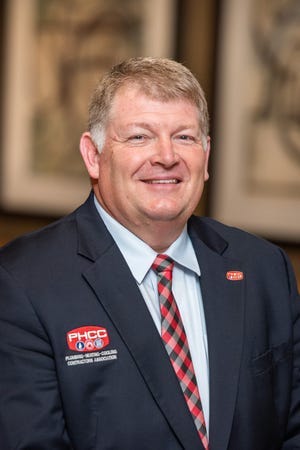 Recently, Mechanical Hub had the chance to talk with Joel Long, co-owner of GSM Services, Gastonia, N.C., and PHCC president-elect. Running the nearly 100-year-old business with his brother Steven. Joel started to work for the family business during high school summer breaks and fell in love with the business. After high school, Long attended North Carolina State University and graduated with a Bachelor of Science (BS) degree in Civil Engineering and Construction and started working for the family business upon graduation. In the following Q&A, Joel talks about his vision for PHCC and some critical issues facing contractors today.
Recently, Mechanical Hub had the chance to talk with Joel Long, co-owner of GSM Services, Gastonia, N.C., and PHCC president-elect. Running the nearly 100-year-old business with his brother Steven. Joel started to work for the family business during high school summer breaks and fell in love with the business. After high school, Long attended North Carolina State University and graduated with a Bachelor of Science (BS) degree in Civil Engineering and Construction and started working for the family business upon graduation. In the following Q&A, Joel talks about his vision for PHCC and some critical issues facing contractors today.
MH: What does the position of PHCC president mean to you?
LONG: I am honored to have this opportunity to serve our industry and association after it has given so much to our company and to me personally. I am thrilled to such a big opportunity to continue the work of those who have served before me and to make a little progress for our members and partners.
We are in a unique position to understand the depth of caring from the PHCC family. As many may know, tragedy befell GSM Services in April of this year with the murder of two of our coworkers. It was devastating to say the least, but PHCC members supported these two families on a massive scale and proved once again there is more good in the world than evil.
MH: What are some things you can take from your career that you can apply in the next chapter as president of PHCC?
LONG: There is nothing quite like the experience you gain while growing up in businesses like ours and then growing into a leadership position in that same business. I have spent a lot of time at the state and national levels seeing what works, what causes issues, and what is broken. I am going to use that experience to hopefully continue to move us forward.
MH: How do you think being in the trades will guide you as the next president of the PHCC?
LONG: I think I fell in love with our trade because the people at all levels are just the best of America. I have always loved how we have a “can-do” attitude and can conquer anything while focusing on our families and doing what is right. PHCC will be operating that same way in my year as president like we have since our founding.
MH: The last 18 months has been quite the experience. What do you tying will be some of your initiatives going forward as we seem to be moving post-COVID?
LONG: I would say we may look back and see these two years as some of the most challenging in our careers. Our members faced many challenges related to the pandemic and PHCC was able to provide a ton of assistance on those fronts.
Our members were deemed essential during the pandemic and continued to send our workforce into client’s homes and businesses as the disease raged. Protecting both customers and coworkers was a major concern all-across the country. PHCC got out front early with our Covid Recovery Center and our members were able to use our center to stay informed of changes and best practices to overcome the pandemic issues. We will be continuing that effort.
I also believe it is time to get back out on the road and live without fear. We are going to lead by example and get our association moving back in a pre-pandemic mode. We must be as safe as possible and respect the concerns of the public, but at the same time we must get back to work on a full-size scale!!!! It’s time to go!
MH: What is your vision to take PHCC to the next level?
LONG: PHCC is a federation of state and local associations and I believe it works best when each level is openly communicating and helping each other reach our individual and combined goals. Communication and collaboration are key to our mutual success. There are so many different opportunities across the country, and we must be very nimble and targeted in our approach to help our partners. We are here to serve our contractor members first and foremost, but our customers are also our state associations. Strengthening those relationships and building on small successes is how we will take PHCC to the next level.
MH: What are some critical issues facing contractors today?
LONG: I have heard from contractors all over the country and they are concerned about how they are struggling to get back to work through all the roadblocks we have been facing this past year or so. We will obviously continue to see the pandemic making us adapt our businesses going forward, but there are also opportunities for growth all around if we continue to search for them. I encourage our members to use PHCC and our members as resources to help find new growth opportunities and information to help your business thrive.
MH: How do we find and inspire the next generation of coworkers?
LONG: I love the movie The Untouchables with Kevin Costner and Sean Connery. One of my favorite scenes is when they are trying to find uncorrupted new recruits for the Treasury Department and they decide to go to the academy to get untainted recruits. We need to do the same to find the next generation.
Before the pandemic, PHCC had developed our online apprenticeship program and we were already having good success in giving students a pathway for a career. As the pandemic grew, our members really started using this as a recruiting tool to convince high school students and their parents that a career in our industry made a ton of sense without the college debt.
I believe today’s youth is looking for a career that helps them grow intellectually, gain financial independence, give opportunities to improve the world, and have opportunities for career advancement. We must continue to get he word out about how our industry can help them achieve their goals.
We must also continue to expand these efforts by widening the exposure of this program to other avenues on a state be state level. We will be encouraging our chapters to partner with as many local school districts, community colleges and HBCU’s about how to expand our opportunities.
MH: Finally, what do you like to do in your spare time?
LONG: I am a sports nut and love college football. I have followed NC State athletics since elementary school and continue to follow today, and as I say every year, this is the year we win the College Football National Championship! Eventually I’ll be correct, right? Also, if you bump into me and have an extra hour, just ask me about being at State when Jim Valvano was our basketball coach.
I also love fishing. Grew up with my father fishing on many Saturday mornings, and I love the time to unwind and reflect from the business. I also love the variety of fishing in N.C. We have wonderful fishing in the intercoastal waters, fresh water lakes all over the state, and my current favorite, trout fishing in the North Carolina mountains.
